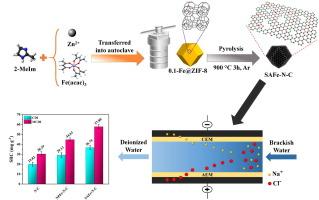Single-atom Fe in N-doped hierarchical carbonaceous structure derived from MOF: A pathway to high-performance CDI and MCDI
IF 8.1
1区 工程技术
Q1 ENGINEERING, CHEMICAL
引用次数: 0
Abstract
Capacitive deionization (CDI) is an efficient method for brackish water desalination with low energy consumption. The effectiveness of CDI relies on the optimal engineering of electrode materials to enhance salt removal capacity (SRC). Carbon-based materials, through morphological optimization and heteroatom doping, have shown improved performance. Iron-based carbonaceous structures are promising candidates for enhancing electrode capacitance in CDI and membrane capacitive deionization (MCDI) systems. This study investigated the synthesis of nitrogen and metal co-doped porous carbons via carbonization using a metal-organic framework (MOF). The performance of single-atom iron embedded in nitrogen-doped carbon (SAFe-N-C) was compared to iron nanoparticles integrated into nitrogen-doped carbon (NPFe-N-C) and nitrogen-doped carbon (N-C). Electrochemical evaluations in a 1.0 M NaCl electrolyte demonstrated that SAFe-N-C, as the optimized electrode, benefited from uniform adsorption sites, reduced internal resistance, excellent stability, and a specific capacitance of 117 F g-1 at 2 mV s-1. It also achieved SRCs of 36.7 mg g-1 and 57.8 mg g-1 from a 500 mg L-1 NaCl feed solution at 1.2 V during CDI and MCDI tests, respectively. Therefore, atomically dispersed Fe in the hierarchical porous N-doped structure can be a promising alternative for enhancing CDI and MCDI performance. Density functional theory (DFT) calculations indicated that effective Fe–N groups serve as active sites, promoting charge density redistribution and improving ion affinity, leading to substantial SRC. This study provides insights into the critical role of Fe–N sites in carbon-based CDI and MCDI enhancement.

求助全文
约1分钟内获得全文
求助全文
来源期刊

Separation and Purification Technology
工程技术-工程:化工
CiteScore
14.00
自引率
12.80%
发文量
2347
审稿时长
43 days
期刊介绍:
Separation and Purification Technology is a premier journal committed to sharing innovative methods for separation and purification in chemical and environmental engineering, encompassing both homogeneous solutions and heterogeneous mixtures. Our scope includes the separation and/or purification of liquids, vapors, and gases, as well as carbon capture and separation techniques. However, it's important to note that methods solely intended for analytical purposes are not within the scope of the journal. Additionally, disciplines such as soil science, polymer science, and metallurgy fall outside the purview of Separation and Purification Technology. Join us in advancing the field of separation and purification methods for sustainable solutions in chemical and environmental engineering.
 求助内容:
求助内容: 应助结果提醒方式:
应助结果提醒方式:


